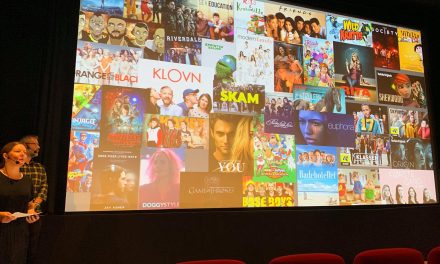With the Christmas period well and truly upon us, it seems only fitting to consider the time-honoured, festive tradition of bingeing. For better or for worse, Christmas has become synonymous with the act of bingeing – not just because of the copious amounts of mince pies and mulled wine that we might consume, but also because of the increased amount of television that we typically view during the festive period.
Of course, if we are to go by the strictest definition of bingeing as the consecutive viewing of multiple episodes of the same television programme – which, as Casey McCormick notes, ‘many analysts define as watching three or more episodes in a row’ (2016: 101)[i] – then perhaps this is not the most accurate way to describe our Christmas viewing habits after all. Even with this semantic caveat in mind, I would argue that it is still productive to consider the practice of bingeing in relation to Christmas television, not only because both have a great deal in common, but because the latter also highlights a number of issues that have largely been ignored in critical studies of the former.
As such, this post will use Christmas television to draw attention to some of the formal and experiential features of bingeing (with particular emphasis on those programmes released all-at-once and therefore more prone to this consumption mode). Though a comparative approach could reveal numerous other similarities between them, this post will focus on just one: the practice of themed releases.
The new trailer for the aptly titled Mystery Science Theatre 3000: The Gauntlet which openly challenges Netflix subscribers to binge as many instalments as possible.
THEMED RELEASES
Just as Christmas programming tends to be highly thematic and/or topical in its subject matter, all-at-once series are also often characterised by a niche thematic focus. Unlike Christmas television, however, all-at-once series are released at various times throughout the year and thus their collective generic and thematic range is much more diverse. Over the past couple of months alone, Netflix has released a number of series that demonstrate this fact. For instance, over the Halloween and Thanksgiving period, the SVOD giant debuted two prominent, horror-themed series, The Haunting of Hill House (2018 – ) and The Chilling Adventures of Sabrina (2018 – ) – the latter of which even takes place across the Thanksgiving period and has a forthcoming Christmas special. Around the same time, Netflix released the sixth and final season of House of Cards, just four days before the US midterm elections. In each instance, the release was strategically timed in order to exploit a thematic coherence between the narrative and real-world events.
In addition to these very recent examples, we can add many other Netflix Originals to this list. The release of each of the previous five seasons of House of Cards, for example, has coincided with various significant events in the political calendar. For instance, the first season debuted just days after Barack Obama’s second inauguration, thus capitalising upon a heightened interest in American politics at the time.
Netflix’s proclivity for themed releases doesn’t stop there. Another example of this strategy can be seen in the release schedule of Orange is the New Black (OITNB) which has been consistently timed to coincide with LGBT Pride Month (which takes place in June)[ii]. Thus, just as House of Cards has sought to continuously ride the wave of heightened public interest in American politics, the strategic release of OITNB has better positioned it to be able to participate in and contribute to discourses related to the LGBT+ community.
Another notable albeit less political example of this themed release strategy occurred with the popular horror/sci-fi series Stranger Things, specifically its most recent second season. Released just days before Halloween 2017 (October 27th to be precise), it features a distinctly horror and Halloween-centric narrative that spans exactly one week, running from October 30th to November 5th 1984[iii]. Like The Chilling Adventures of Sabrina, the sophomore season of Stranger Things is another good example of the temporal (Halloween) and generic (horror) synchronicity that exists between the diegetic and extradiegetic timelines of many all-at-once releases.
Given Stranger Things’ obvious generic fit with the Halloween period, it may come as a surprise that the upcoming third season is scheduled for released in the summer of 2019. However, in a trailer released earlier this week, it was confirmed that the narrative itself would take place during the summer of 1985 – roughly six months after the conclusion of the second season. This ended months of speculation following a much earlier teaser trailer that was released by Netflix in July of 2018 (see below). The trailer in question features a distinct tonal shift (from horror to comedy) and temporal shift (with its notable summer aesthetic), demonstrating yet another symmetry between the diegetic and extradiegetic temporalities of all-at-once releases such as Stranger Things. It is also interesting to note that Gaten Matarazzo (who plays Dustin) recently revealed that the third season would be ‘darker but funnier’, indicating that the timing of its release during the summer months will have a bearing on the look and the tone of the series itself.
A teaser for the third season of Stranger Things, due out in the summer of 2019.
Themed releases are hardly a novel strategy within the broader context of the entertainment industries, with film distributors and exhibitors having long practiced this approach (horror movies at Halloween, rom-coms released in time for Valentine’s Day, and so forth). The same is also true of television, which has a long history of producing one-off specials or individual episodes of series that tie-in to real world events (such as a Christmas special for a sitcom).
However, all-at-once series are different to their more conventional “broadcast” counterparts in that they don’t have quite the same opportunity or incentive to feature stories or scenarios that span a more expansive timescale. A season of a US television sitcom, for example, will typically begin broadcasting around mid to late September before concluding in late May, giving writers more natural opportunities for their characters to experience a broader range of events across a given year (e.g. heading off to college at the beginning of the academic year, celebrating holidays such as Christmas, Thanksgiving, or the new year).
What we therefore see in a number of all-at-once series is a kind of temporal compression often coupled with generic or thematic confinement. In many cases, narratives are compressed in a way that mirrors our own binge-viewing experience – the plots of both Stranger Things and The Chilling Adventures of Sabrina unfold across a week or so, whilst a mere three days pass in the narrative arc of OITNB’s fifth season. Likewise, the practice of all-at-once releases often results in programmes which are very refined in terms of their generic and thematic range.
As a consequence of this, the characters in all-at-once releases often seem trapped within a rigid generic or temporal framework. Indeed, this was so eloquently articulated by Stella Gaynor just a couple of weeks ago on this very blog in her discussion of the confinement that characterises The Haunting of Hill House. In her post, Gaynor describes the generic, spatial and temporal confinement of the series. And I think that we can extend and apply this idea to many of the other all-at-once series discussed here. For example, it is integral to the plot and ambience of Stranger Things that the town of Hawkins and its residents are cut-off and confined from the rest of 1980s America. In Ozark, another Netflix Original, Marty Byrde and his family are trapped in an endless-cycle of money laundering, forced to take a series of increasingly desperate measures in a seemingly futile attempt to sever their ties to organised crime. Meanwhile, in what might be the most literal example of all, confinement is central to the very premise OITNB.
I’m not at all suggesting that this kind of temporal and thematic/generic confinement is necessarily a bad thing. If anything, the examples above demonstrate that it usually works to compliment the themes of many all-at-once releases (particularly so in the case of The Haunting of Hill House, Ozark and OITNB). Moreover, the highly thematic nature and carefully timed scheduling of the all-at-once release often results in more nuanced examinations of particular themes or issues (e.g. American politics or LGBT+ identity) which might only receive a cursory consideration within the wider temporal scope afforded to broadcast television series.
And so, just as our interpretation and reception of Christmas television is inextricably tied to the festive period, we should keep in mind that, despite their all-year-round availability, all-at-once series are also often connected to and characterised by specific moments in time.
JP Kelly is a lecturer in film and television at Royal Holloway, University of London. He is the author of Time, Technology and Narrative Form in Contemporary US Television Drama (Palgrave, 2017). He has published essays in various books and journals including Ephemeral Media (BFI, 2011), Time in Television Narrative (Mississippi University Press, 2012) and Convergence. His current research explores a number of interrelated issues including narrative form in television, issues around digital memory and digital preservation, and the relationship between TV and “big data”.
Notes:
[i] Netflix’s definition of binge-watching is a bit more nuanced than this and includes a range of other viewing vocabulary such as “savouring” and “devouring”. See: https://media.netflix.com/en/press-releases/netflix-binge-new-binge-scale-reveals-tv-series-we-devour-and-those-we-savor-1
[ii] For a more detailed consideration of this strategy, see: San Filippo, Maria (2017) ‘Doing Time: Queer Temporalities and Orange Is the New Black’, in The Age of Netflix: Critical Essays on Streaming Media, Digital Delivery, and Instant Access, Myc Wiatrowski and Cory Barker (eds). McFarland, pp. 75-97.
[iii] With the exception of the closing moments of the final episode of season 2, which jumps ahead approximately 8 weeks in the timeline, to December 15th, 1984.
Works Cited:
McCormick, Casey (2016) ‘”Forward is the Battle Cry”: Binge-Viewing Netflix’s House of Cards’, in Kevin McDonald and Daniel Smith-Rowsey (eds) The Netflix Effect: Technology and Entertainment in the 21st Century. New York, London: Bloomsbury, pp. 101-116






